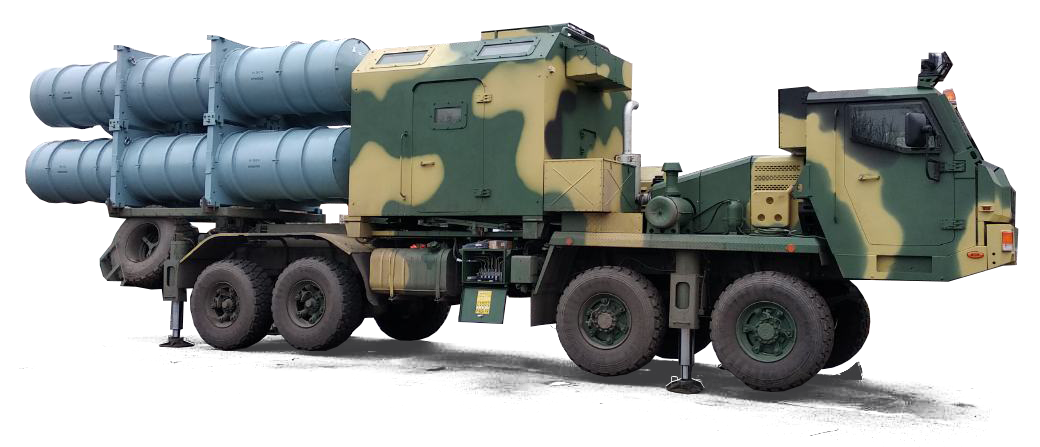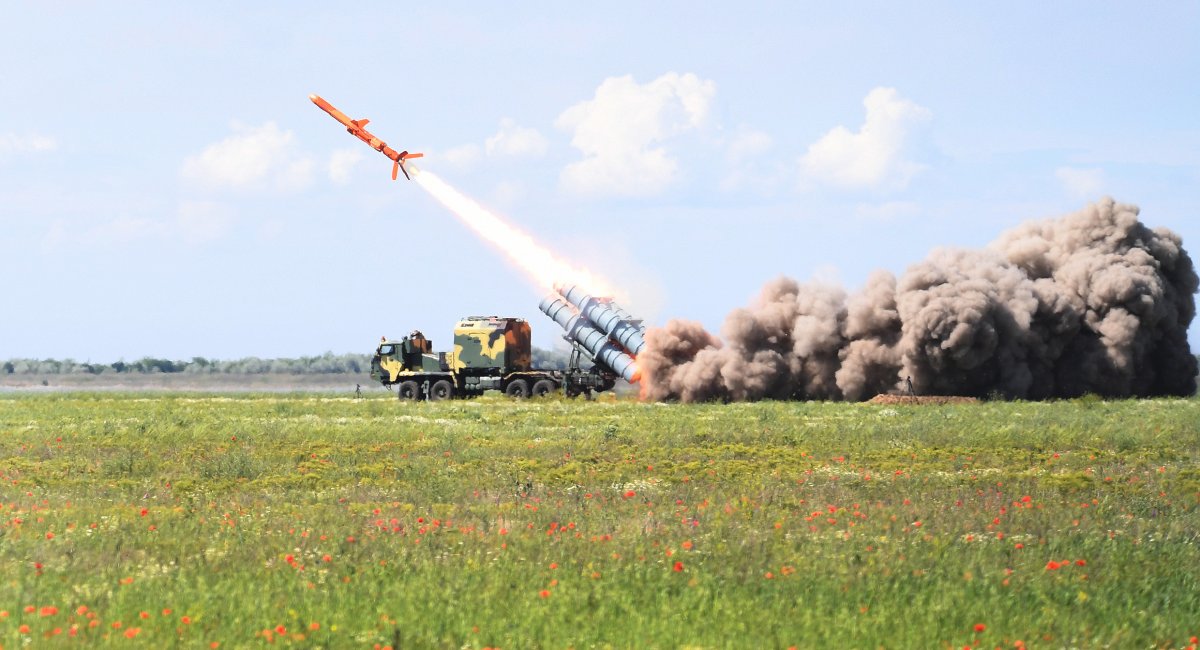DKKB Luch, a State-owned Design & Development Company, is the Prime Contractor for the Neptune ASCM system Neptune.
The Neptune is a domestic collaboration involving both state-owned and private-sector defense contractors.The project is aimed to provide Ukraine with a cost-effective 300-km-range ACSM capability.
Read more: Ukrainian Defense Ministry to buy Neptune anti-ship missile system this year
Finaltrials
The closing round of the OQT program for the Mobile ASCM System Neptune took place at Ali Bay marine testing range, outside Odesa, in the period from April to June 2020.

Thus, on April 2 there was conducted a test firing against a surface target using a non-explosive warhead. The missile, after being fired from Neptune launcher vehicle, flew to the target area by following a pre-programmed path formed by predefined waypoints. Navigation was performed by fusing inertial and GPS measurements with radio altimeter data. In midcourse, the missile was skimming over the sea at the lowest height possible. At this low sea-skimming height the missile will be less detectable by enemy sensors and less vulnerable to air defense countermeasures.
A lighter ship of 38 m in length and 11 m in width, located about 100 km off the shore was used as the test target.
The missile successfully hit its target with high accuracy.

This was followed by test firings conducted from 25 to 29 April in realistic mission scenarios that involved the use of naval warships and aircraft and saw actual jamming attacks being launched to frustrate and disrupt the missile guidance systems. It was reported that two successful launches had been made against a lighter ship used as a simulated target.
The tests continued on May 26-29, with several R-360 missiles fired simultaneously at different targets. As explained by the Chief of Design at DKKB Luch, Oleh Korostelev, "Parameters of the targets regarding flying trajectory, distance and lock-on time were preloaded into the memory of each of the seeker heads...".
“At a distance of about 10 to 15 kilometers from two assumed points of impact the missiles descended to 5 meters above the Black Sea surface, then calculated the most probable point of impact, flew the remaining path and hit two ship targets," Mr Korostelev said.

June 17, 2020 saw the first ever live test-firings of the Neptune ASCM. As claimed by DKKB Luch, Russia attempted to interfere and frustrate the testing process by taking electronic countermeasures, but failed to succeed: the two missiles launched successfully reached and destroyed their assigned targets. Moreover, the flight plan for the second missile was promptly updated from the Ground Control Center to incorporate relevant data from the first missile launch.
The sea-skimming height of the second missile was decreased to three meters. This second missile successfully hit and destroyed a sea-floating platform loaded with several sea cargo containers of a test-specific mass.
Now that the missile test firing program has been successfully completed, it can be hoped that the Neptune ASCM system will be officially accepted into service and fielded by Ukraine’s military as early as in 2020.
Neptune ASCM System in all its glory
The RK-360MTs ‘Neptune’ is a shore-based ASCM system optimized to fire the cruise missile R-360. The Neptune missile is intended to be used against surface combatants like cruisers, torpedo boat destroyers, frigates, and corvettes, as well as amphibious landing ships and transport vessels sailing in strike groups (convoys) or individually, and it would be effective also against radar-detectable targets on the shore.

The Neptune is being designed as a day/night all-weather weapon system capable of operating in severe ECM environments and under heavy enemy counterfire. It would be able to engage targets at ranges from 7 to 280 km.
The Neptune would be able to achieve its full capability if deployed no farther than 25 km from the coastline.
Full salvo – 24 missiles.
The time lag between missiles launched in a salvo – 3…5 s.
Time from the end of mission to ready-to-fire time for the next mission – ≤15 min.
ASCM Neptune vehicle range – ≤1,000 km.
The Neptune ASCM Battery includes:
- Command-and-control post vehicle equipped (1) for automatic control of the System’s operation, (2) to ensure sustainable communication (over HF, UHF and satellite) with higher echelons and other Neptune vehicles. The five-member crew can emplace the command-and-control post and have it ready for mission in no longer than 10 minutes.
- R-360 missile in the TPK-360 storage/transport/launch canister. Armed with a 150-kg warhead, the 870-kg, 380-mm diameter missile would skim over the sea at a height of 3…10 m. It will have a maximum range of 280 km.
- Unified launcher system USPU-36 is equipped for temporary storage, transport, pre-launch preparation and launch of R-360 missiles.
- Transporter/transloader vehicle T3M-360 carries TPK-360 canisters with R-360 rockets.
- Ground support equipment kit KMO.

The composition of the Neptune Battery can be configured to meet specific Customer needs.A Neptune battalion would typically consist of: (1) mobile command and control post, (2) three launcher batteries consisting of two SPU-360 launchers each, (3) operational support battery consisting of six transporter/transloader vehicles each carrying one storage/transport/launch canister TPK-360, (4) logistical units. Each Neptune battalion will have a standard missile establishment of 72.


The State Enterprise DKKB Luch, Kyiv, is the primary contractor for the Neptune ASCM System. The Neptune Project is a collaboration involving domestic entities only, including but not limited to: Orizon-Navigation, Impulse, Visar, Arsenal TsKB, Radionix, Telecart-Prybor, UkrInMash, Ukrainian Armored Vehicles, Motor-Sich, and KrAZ.
The Neptune ASCM System technology offers a number of important competitive advantages in the following ways:
- In terms of capabilities versus cost trade-offs, the R-360 missile, while being cheaper to buy, exhibits performance capabilities roughly comparable to those of best international brands from the U.S., Sweden, PRC, and Russia. Being fully indigenous it eliminates reliance on foreign sources of components and subsystems.
- The Neptune can be integrated with any of the existing foreign-produced ISTAR assets by networking the Neptune command-and-control post vehicle with Customer’s systems. It can also operate autonomously by using targeting data obtained externally from reconnaissance missions and aerial surveillance from manned/unmanned aircraft.
- The System can be located for production in the Customer’s home country. In particular, it can be mounted on any wheeled chassis brand with off-road performance as required by Customer need.
- The ASCM Neptune is unified for launch from land, sea and air platforms.In Ukraine, it was test launched from missile boats and is being adapted for launch from the Su-24M-type strike aircraft (Su-27 objective). The configuration optimized for air launches will be designed without a canister, enabling the missile to be delivered from standard aircraft rocket launchers like APU-78 or AKU-58.
Moving forward to new frontiers
The family of Neptune ASCMs is currently being expanded to include configurations optimized for sea and air launches in addition to the ground-launched baseline.



From the economic perspective, the baseline configuration of the missile has optimum parameters in terms of full-rate series production, requirements on the materials used, production processes, machinery and other manufacturing technology.
The Neptune ASCM rates relatively high among rival technologies worldwide in comparisons of cost and effectiveness.
The experience gained so far with developing this new ASCM capability reveals much room for modernization of both the unified subsonic missile and other System components.
DKKB Luch is already working on some of the upgrades to improve the tactical, technical and operational parameters of the Neptune ASCM system. But, of course, it is the feedback from the military customer that will matter most in this respect.
Military weapons designers are stressing that advances in microelectronics, computer technology and artificial intelligence, combined with the automation of military command and control will be the key drivers behind quality based transformation of ASCM weapons and related doctrine, organization, capabilities, training, tactics and procedures.
So, future history for the Neptune is already in writing.
Read more: Ukraine has created new missile systems













